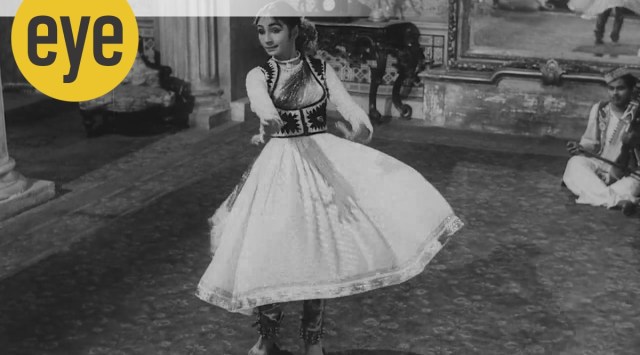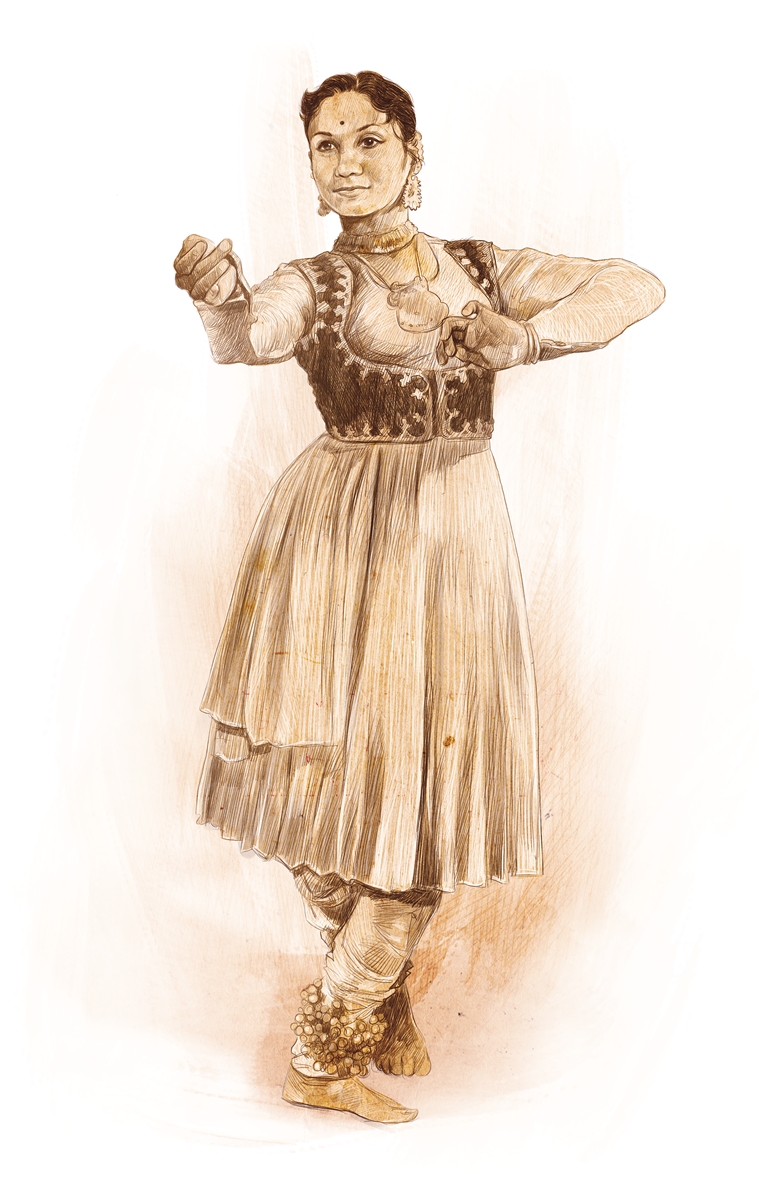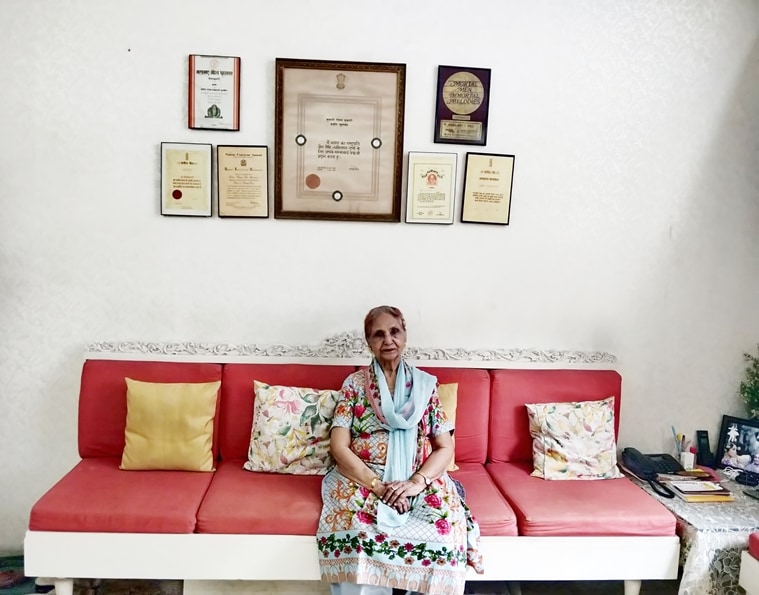The Story of a Reclusive Dancer: Roshan Kumari, who once lit up the world of Kathak
In a rare interview, Roshan Kumari, part of the feted Kathak trinity with Sitara Devi and Damayanti Joshi, speaks of her devotion to dance, the iconic performance in Satyajit Ray’s Jalsaghar, and what her journey steeped in Kathak has given her
 A still from Jalsaghar, where Roshan Kumari performs at the zamindar’s music room.
A still from Jalsaghar, where Roshan Kumari performs at the zamindar’s music room.
Often, the most fascinating conversations are those that have been pent up for too long. So, when veteran Kathak exponent Roshan Kumari, who has stayed away from the spotlight for decades, turned us down for an interview, her fourth in a span of two years, we realised it isn’t about being ready.
Interviews have always bothered the 84-year-old. Not only because she can’t stand questions like “where were you born?” or the more personal ones like “why did you never marry?”, but also because if she does agree to discuss her life and art, she finds it distressing to re-relive the pain of the years gone by.
Buy Now | Our best subscription plan now has a special price
One sees glimpses of her journey in films and in a Films Division of India-documentary, titled Kathak (1970). In these, one never hears Kumari’s voice. There are almost no interviews of her, be it in print, on audio or video. In the world of art and posturing, Kumari has done something that seems implausible. She has let go of an artiste’s primal need — to be remembered.
“I don’t even dance any more. Why would you even ask questions of me? I have nothing to say,” she says, on our fifth phone call. “But what if there are no questions? No photographs. Only a conversation over tea, where we’ll discuss the arts, the artists and their significance,” we ask. The five-second-long pause is excruciating. There is a drop in the sharpness of the tone, “Aao tum ghar. Phir dekhenge. Akeli aana (Come home. We’ll see then. Come alone)”.
******
In the build up to the climax of auteur Satyajit Ray’s evocative masterpiece, Jalsaghar (The Music Room, 1958), the high point is Kumari’s nine-minute performance, remembered for its brilliance. Performing a traditional chaturang (four-part composition) of the Jaipur gharana just after Ustad Waheed Khan’s alaap, Kumari fills up the performance with a highly technical tora, tukra, parans and Krishna-inspired gatt-bhaav, accelerating into complexity through percussive footwork in front of a giant, ornate mirror. The whorls she moves in are exquisite — a perfect balance of precision and bhaav.
While four cameras track her every move, one also sees in the mirror her fluidity and swiftness, the men seated on the carpet, drinking and watching her perform in zamindar Biswambhar Roy’s (Chhabi Biswas) music room.
 Satyajit Ray wanted a Kathak performance in Jalsaghar (1958) that went beyond the signature moves of the artform; Ustad Vilayat Khan, the composer for the film, had one suggestion — Roshan Kumari. (Credit: Suvajit Dey)
Satyajit Ray wanted a Kathak performance in Jalsaghar (1958) that went beyond the signature moves of the artform; Ustad Vilayat Khan, the composer for the film, had one suggestion — Roshan Kumari. (Credit: Suvajit Dey)
But one of the golden rules in stage performance, especially in Indian classical dance, is for the performer to never turn her back to the audience, unless she’s returning to the front. But Ray chose to film with the mirror. “Nobody dances in front of a mirror except maybe postmodern dancers. The music introduces the quick tempo and bol in the beginning and the text is minimal, unlike a true Kathak performance with its emphasis on literature. The mirror provides a Jungian shadow (the reprehensible side) to the zamindars, one they cannot see. The tempo suggests the final spark that flashes before it vanishes marking the dramatic exit of a zamindari way of life. That is masterful storytelling, offering a new perspective that is unique to the story,” says Mumbai-based filmmaker and playwright Mahesh Dattani, who based his Shabana Azmi-starrer Morning Raga (2004) on the world of Carnatic classical music.
Ray’s mirror sequence has always been lauded for its filming and direction. But what went behind that camera is the story that not many know. The film has this zamindar who flaunts his affluence, is a patron of the performing arts, who hosts the best music-and-dance baithaks. The performance, therefore, had to be exceptional. Ray wanted a Kathak performance that went beyond the signature moves of the artform. Ustad Vilayat Khan, the composer for the film, had one suggestion — Roshan Kumari — a 19-year-old dancer, the shagird (disciple) of Pandit Sundar Prasad of Jaipur gharana.
According to Indore-based veteran Kathak exponent Puru Dadheech, who also learnt from Prasad, “It’s hard to imagine a young girl pull off this level of brilliance. That perfection is a result of not just hard practice or a deep understanding of the complex mathematics of the rhythms, but it brings to the fore something else — the art of stillness, which is as significant as movement. Her footwork is magical and incisive but it’s the intensity of the stillness that is her hallmark. Dancers such as her come by rarely.”
******
Kumari’s home is a small two-bedroom apartment on Waterfield Road, in Mumbai’s Bandra. The entrance to her building, Kashi Kunj, has a board dangling on the metal gate. ‘Padma Shri Roshan Kumari, Nritya Kala Kendra’, it reads. As I ring the door bell, an elderly lady in a sky-blue salwar-kameez with henna-dyed hair opens the door. “Dikkat toh nahi huyi (It wasn’t any trouble, was it?),” she asks, in a Punjabi accent. Time may have left its mark on her face and gait, but the central parting of the hair tied in a plait and the smile with pursed lips are a reminder of that entry in Roy’s music room.
Her student of 30 years, Mukta Joshi, waits behind Kumari. In a stark white, freshly distempered living room, with a red-and-white vintage sofa, is her Padma Shri citation along with a bunch of other awards, and pictures of Kumari from her younger days — dancing in Ray’s Jalsaghar, with Lata Mangeshkar at her brother Hridaynath’s wedding reception, with her mother and legendary singer Zohrabai Ambalewali. But the towering presence in the room is that of her father — percussionist Choudhury Fakir Mohammed — whose large, black-and-white portrait is on a wall.
Not just in the room, but even in Kumari’s life, Fakir Mohammed has been the most significant person, even though her mother was the equally renowned famous Zohrabai. When Kumari was growing up in Haryana’s Ambala, Zohrabai, who was from a family of professional musicians, was already an artiste for All India Radio. At home, she tried teaching her daughter the ragas. But Kumari, an only child, was not interested. “My mother was very good at it but I didn’t think I had the voice,” says Kumari.
She was moved by her father’s tabla and pakhawaj, the beats felt like a larger force. Her father, a sessions musician in the film industry (he played the tabla in many songs, including Mohd Rafi’s Koi sagar dil ko behlaata nahi, in the film Dil Diya Dard Liya, 1966), decided that his little girl would dance. “My relationship with my father was very different. Baoji and I had some kind of soul connection. I was also his gandabandh shagird (disciple for life). I have loved dance because of his passion for rhythm. Whatever I could do was because of my father, his riyaaz. I could play in the complex world of rhythms because of him,” says Kumari.
In Mumbai, Kumari’s tutelage began at the age of five under KS Moray, who was a dance director in the films of the ’40s and ’50s. After learning the basics of Kathak from Moray for a few months, Mohammed sent her to learn from Prasad, who was a student of the legendary Bindadin Maharaj of the Lucknow gharana. Since she never went to school, she was home-tutored.
At home, her father would play the pakhawaj and she’d dance. The reverberating sound of the ghungroos making her want to excel more. “I was very sharp and could very quickly pick up what my gurus taught me. During the long riyaaz sessions with my father, it was as if I would drink up that piece. He worked as hard as me. His life was completely devoted to my dance,” says Kumari.
 Roshan Kumari at home in Mumbai (Credit: Suanshu Khurana)
Roshan Kumari at home in Mumbai (Credit: Suanshu Khurana)
At the time, women in dance weren’t given much respect. A Muslim girl dancing the Krishna leela would be frowned upon. But Mohammed didn’t care. To him, his girl was talented, and she was made for dance.
Her first solo concert was at age 13 in Kolkata, with an audience of 1,500 people in a maidan. “This performance created a stir in the world of dance. Mera naam Calcutte se hi huya. I was suddenly famous,” says Kumari, who was awarded the Vishwa Unnyyan Samsad Award in 1989 by the government of Bengal. “They washed her feet, made her sit on this huge chair decked up with flowers. We thought it must be for the governor,” chimes Joshi, her student, who had accompanied her.
After her performance in Kolkata, invitations to all the major music conferences began to pour in, Kumari began touring the country. Meanwhile, she learnt Bharatanatyam for about six months under Govindraj Pillai and Mahalingam Pillai in Mumbai. At 15, she also did a short performance for director Bimal Roy’s Parineeta (1953).
About four years later, Ray and Vilayat Khan came knocking at her parents’ SV Road bungalow. “When Ray sahab came, my father said that he didn’t need to come to our house and that he could have called us to his office. Ray sahab said that ‘The artist lives here, so I need to visit and request’,” says Kumari.
Ray asked her to just dance and not stop. He would do the rest. “My headgear opened while dancing. You can still see it in that sequence. But I didn’t stop,” says Kumari, who was known to have the heaviest ghungroos, which would have made the precision of the rhythm tough.
Invitations also came from the Rashtrapati Bhavan and for government events. But the aplomb was only for the stage. At these performances, “Hum sar jhuka ke jaate thhe, perform karte thhe, aur seedha ghar aa jaate thhe (We would keep our heads down while going in, perform, and return home),” says Kumari. She was also the choreographer for films such as Chaitali (1975), Lekin (1990) and Sardari Begum (1996). She has been awarded the Sangeet Natak Akademi award in 1976 and the Padma Shri in 1984.
In 1994, Fakir Mohammed passed away. “I have not touched my ghungroos since then,” says Kumari, welling up looking at her father’s portrait. “It’s difficult to speak about my dance because it’s tied to him. I plunge into a dark space, which is why I do not do interviews,” says Kumari, who never married, “It is quiet and lonely but my students are wonderful and keep visiting.”
Saira Banu, too, learnt Kathak from Kumari in the ’60s when she was a budding actor. “I never thought that it would turn into a lifelong friendship with Yusuf sahab (Dilip Kumar) and her. Bohot pyar diya dono ne (They gave me a lot of affection),” says Kumari. They were regular chief guests at her annual dance festival on Guru Purnima in Mumbai.
Though Kumari never performed after 1994, she did choreograph and continues to teach students. She almost never watches her own performances. “I find them very strange. Also, I will start finding errors,” says Kumari, with a laugh, the first one in the last two hours.
She insists on lunch, which is aloo ke paranthe and pudine ki chutney. Even after years in Mumbai, she still isn’t fond of Maharashtrian food. The Punjabi in her loves her paranthas. “Tumne sawal nahi kiye. Aisa laga do dosto ne baatein ki. Likh lena tum sab interview mein. (You didn’t ask questions. It felt as if two friends were talking. You can write everything in the interview).”
- 01
- 02
- 03
- 04
- 05































